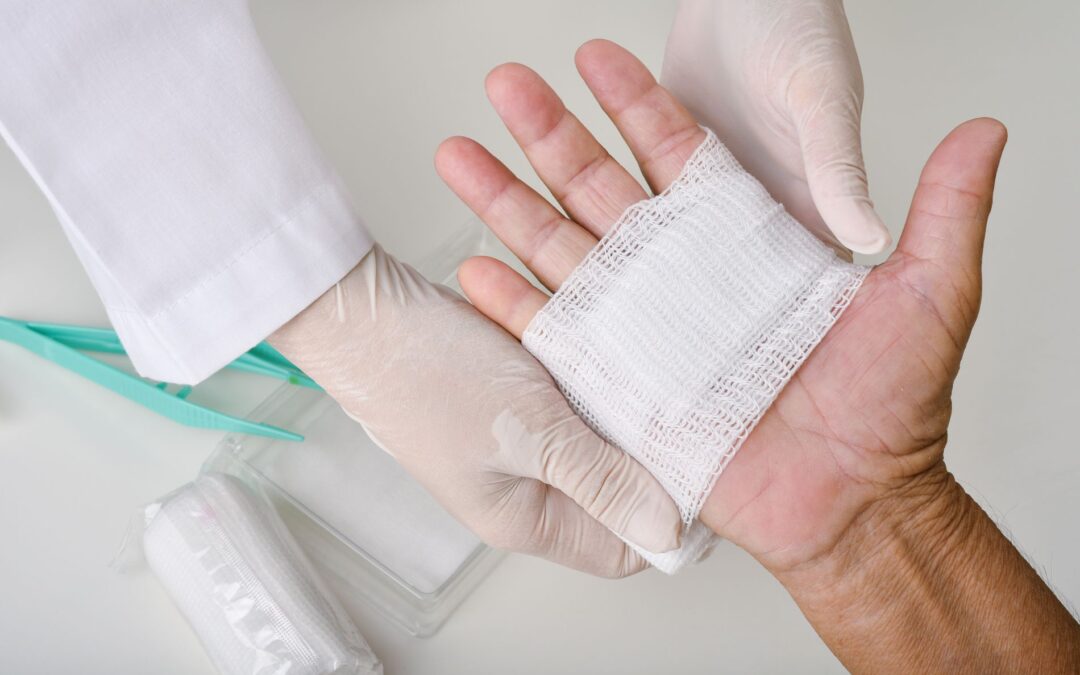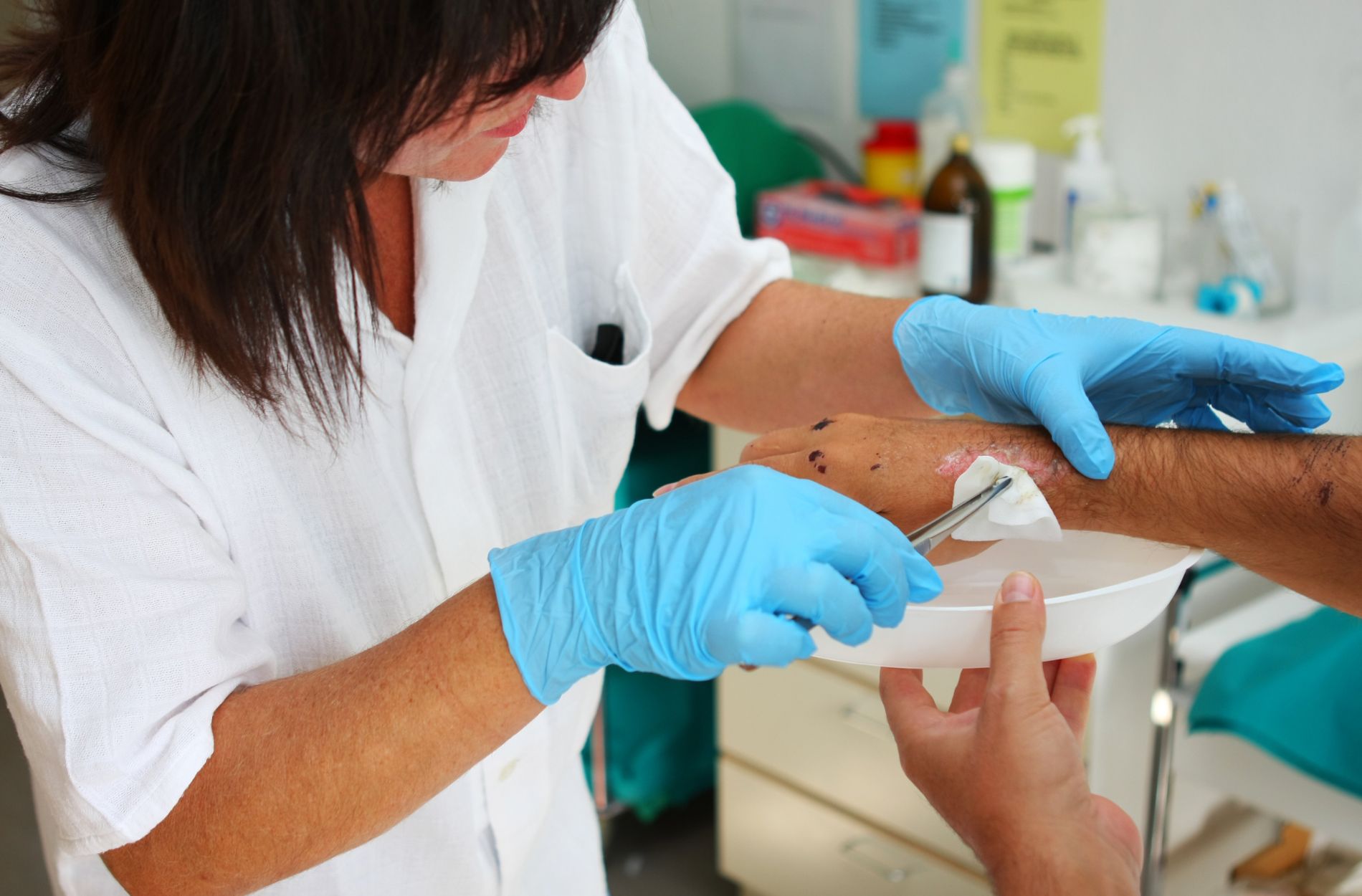Most people have treated a scrape or small cut at home. Clean it, put on a bandage, and wait for it to heal. But when wounds become deeper, larger, or more complex, care gets a lot more involved. Trying to handle a serious wound without professional help can lead to delayed healing or even bigger problems. There’s a big difference between short-term fixes and long-term care that supports healing the right way from the start.
Wounds don’t always follow a predictable path. Some may look mild but worsen in a few days. Others might close at the surface while trouble brews underneath. That’s where professional wound care steps in. It’s not just about treating what’s visible. It’s about understanding the full picture — what caused the wound, what could slow recovery down, and how to care for it without adding new risks. Professional care can mean faster recovery, fewer complications, and more comfort during the process.
Understanding Professional Wound Care: An Overview
Professional wound care involves more than applying ointment and hoping for the best. It includes a complete assessment, targeted treatment, and consistent follow-up. The goal isn’t just to cover a wound but to understand how it’s behaving, what it’s reacting to, and how to support healing in the best way possible.
Self-care can help in some cases, like mild scrapes or cuts. But wounds from pressure, poor circulation, or long-term illness often need deeper attention. These aren’t just surface injuries. They tie into a person’s movement, nutrition, medication, and other health conditions. Self-care usually stops at surface-level treatment, while professional care looks at every angle.
The main points of difference come down to:
– Expertise: Professionals bring years of training to understand what’s wrong even before something looks serious
– Personalization: Care plans are shaped around the details of the patient’s health
– Tools and techniques: Treatments use professional-grade equipment and products, not just store-bought bandages
– Oversight: Wounds are checked regularly, and plans are adjusted fast if something changes
These differences aren’t just technical. They’re what help a wound move toward recovery instead of infection or scarring.
One example involved a patient in Brentwood with limited mobility after a surgery. Day by day, a small sore on his heel grew worse because it went unnoticed. By the time his family realized it wasn’t healing, it had already become painful and infected. Once a professional got involved, the wound was treated with specialized dressings, pain relief, and pressure adjustments that would have been tough to manage with over-the-counter care. That course of action not only helped the wound but also reduced the stress on the family and patient.
Expert Assessment and Diagnosis
A key part of avoiding complications is getting the first step right — assessing the wound. A good wound care provider doesn’t just glance and guess. They take time to look at the wound’s appearance, location, depth, and surrounding skin. They consider causes, like friction, pressure, or moisture. They also factor in health history, which can affect how a wound behaves.
Here’s what sets a professional exam apart:
1. Visual inspection of the wound’s shape, depth, moisture level, and color to see how far along it is and whether skin around it is at risk
2. Checking for infection such as redness, swelling, warmth, or unusual discharge
3. Evaluating pressure and sensitivity, especially in areas with nerve damage or reduced sensation
4. Looking at mobility and blood flow, which can both affect how well and how fast a wound heals
5. Asking the patient about pain, comfort, and any recent changes in health or activity
Without a proper assessment, it’s easy to make assumptions that delay healing. For example, people often treat drainage as a bad sign, but in some cases, it’s part of the natural healing process. Professionals know the difference.
Professional diagnosis sets the foundation for everything that follows. A rushed or missed detail early on can turn into a longer road to healing. By getting that first step right, future care becomes more targeted and effective.
Personalized Treatment Plans
Once the wound is fully assessed, the next step is building a treatment plan that fits the person’s needs — not just the wound. No two treatment plans are the same, because no two people are dealing with exactly the same set of challenges.
Professional wound care providers make decisions not just based on measurements and pictures, but on how a person feels, moves, eats, and rests. Here’s how that plays out:
– Wound location and pressure points determine the bandaging method
– Movement and mobility guide decisions on how often a dressing should be changed
– Pain levels and tolerance affect how care is spaced out across visits
– Nutrition, fluid intake, and medications influence healing from the inside
Compare that with self-care, where people often follow basic instructions printed on a box or passed along by a friend. These general steps may help a little but usually don’t adjust over time or match the level of care needed. That’s what makes self-care riskier for certain wounds — it’s static rather than flexible.
Professional plans tend to include staging the wound, setting healing goals, tracking dressing changes, and even coordinating with other providers like physical therapists or nutritionists when needed. The plan isn’t locked in from day one. As things change, so does the approach. That kind of care isn’t possible with store-bought bandages or internet advice. It takes direct knowledge, hands-on work, and ongoing conversations.
If someone is managing complicated wounds at home in Brentwood, this kind of care keeps their setup realistic and routines manageable instead of overwhelming. It protects their time and comfort while aiming for better healing.
Advanced Wound Care Techniques and Equipment
Professional wound care goes beyond cleaning and covering. It involves using proven techniques, specialized products, and tools that aren’t available at the drugstore. This doesn’t just make treatment more effective, it makes healing safer and less stressful for the person receiving care.
Advanced wound care might include high-quality dressings designed for different types of wounds, including ones that manage moisture, remove dead tissue, or keep bacteria out. In some cases, negative pressure wound therapy (also called wound vacs) may be used to help close wounds quicker and more fully. These tools are designed to work with the body rather than just mask the problem.
Here are a few examples of commonly used advanced methods:
– Foam dressings that cushion pressure points and protect fragile skin
– Films and hydrocolloid dressings that seal out bacteria while keeping moisture in
– Specialized ointments that support healing by targeting inflammation and building new tissue
– Wound vacuums that gently remove fluids and help wounds close
– Monitoring tools that help track how a wound changes over time
There’s a big difference between a gauze pad bought at a store and a wound-specific dressing designed for deeper and tougher wounds. Self-care items might manage the basics for a few days, but they’re not built for long-term healing. The right tools, used in the right way, prevent setbacks and help wounds actually heal instead of getting worse.
Professional care also means having someone who knows how to use these tools correctly. It’s not just about what goes on the wound, it’s about how and when it’s applied. Too much pressure in the wrong spot or not enough moisture control can slow everything down. A trained specialist adjusts those details every visit, keeping the wound moving in the right direction.
Ongoing Monitoring and Adjustments
Healing isn’t always a straight line. Some days a wound may feel better, but the next day it might look worse. That’s normal. What matters is how those changes are handled. Regular monitoring makes sure small issues don’t turn into big ones.
Monitoring isn’t about checking once and moving on. It’s about looking at patterns, asking the right questions, and adjusting the plan in real time. This kind of follow-up care is often skipped when trying to manage wounds alone. But for people with limited mobility or underlying health issues, it’s one of the most helpful parts of professional wound care.
Changes professionals keep an eye on include:
– Swapping out dressings when wounds enter a new healing stage
– Watching for signs of infection or inflammation and responding early
– Easing pressure if mobility changes or discomfort grows
– Reassessing nearby skin and overall comfort levels
– Changing the care pace to match energy levels or other health shifts
Someone living in Brentwood who recently had surgery may need this kind of support more than they expect. Take a person with diabetes recovering from a knee procedure. The incision may start healing fine, but changes in blood sugar or daily steps can suddenly impact progress. Without regular checks, those setbacks might not be noticed until they’re much harder to fix.
Self-care often ends once a dressing is in place. Professional care never stops there. It follows through with clear direction, adjustments, and listening to what’s actually going on in the patient’s world. That makes healing safer and more comfortable.
Why Good Care Makes All the Difference
Putting trust in professional wound care means more peace of mind and fewer unknowns. It’s not just about faster healing, though that’s part of it. It’s about having someone who knows what to look for, what to adjust, and what can be done right now to keep everything on track.
For those living in Brentwood, this is care that comes to you — no extra driving, no waiting rooms. It’s handled where you live, with care that fits your daily routine. Compassion and know-how come together to make the process less stressful and more successful.
Whether someone is dealing with post-surgery healing, a long-term skin issue, or a wound that hasn’t made any progress, professional care can be the difference between struggling and improving. Regular check-ins, personalized treatment, and tested tools all make this care more reliable and more comfortable over time.
To experience the benefits of personalized care, consider professional wound care in Brentwood. Southern Wound Care offers expert services right at your doorstep, making healing both convenient and efficient. Whether you’re dealing with a complex wound or managing a condition that affects healing, let our professional team help guide you toward a smoother recovery.




